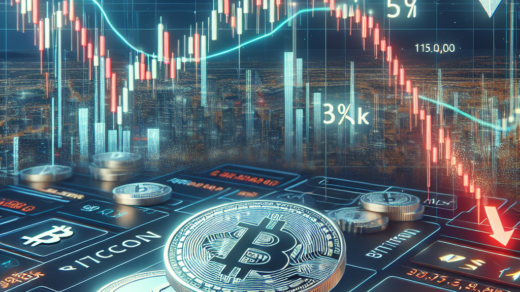Nvidia’s Impressive Market Position
Nasdaq-listed Nvidia (NVDA) has been recognized by Goldman Sachs as the most significant stock of the year, now exhibiting even greater price volatility than leading cryptocurrencies such as Bitcoin and Ether. As the world increasingly turns its attention to artificial intelligence (AI) and graphics processing units (GPUs), Nvidia’s role in the market has become more critical than ever.
Understanding Implied Volatility
The 30-day options implied volatility for NVDA has skyrocketed from an annualized 48% to 71%, according to data from Fintel. This metric acts as a gauge for anticipated price fluctuations over the next month. In contrast, the implied volatility for Bitcoin, as measured by the DVOL index from crypto exchange Deribit, has dropped significantly from 68% to 49%. Similarly, the ETH DVOL index has decreased from 70% to 55%, indicating a decrease in expected price turbulence for these cryptocurrencies.
The Connection Between Options and Market Sentiment
Options are derivative contracts that provide protection for buyers against significant price shifts, whether bullish or bearish. The increase in NVDA’s implied volatility can be attributed to heightened demand for options, reflecting the market’s uncertainty and anticipated price movement. With the rise of AI and the popularity of platforms like ChatGPT, Nvidia has become a key indicator for both equity and crypto markets.
Correlation Between Nvidia and Cryptocurrency
Interestingly, both Bitcoin and Nvidia experienced a downturn in late 2022 but have since shown a robust positive correlation. Current data indicates a correlation of 0.73 in 90-day prices between NVDA and Bitcoin, showcasing how intertwined these markets have become. However, NVDA’s stock has seen a decline of approximately 26% since peaking at $140 last month, which may signal bearish trends for the crypto market as Bitcoin remains locked within the $60,000 to $70,000 range, according to CoinDesk data.
The Role of Market Makers and Negative Gamma
The surge in NVDA’s implied volatility is likely connected to the hedging activities of market makers—a phenomenon commonly seen in the cryptocurrency space. Griffin Ardern, head of options trading and research at crypto financial platform BloFin, noted that negative gamma, which forces market makers to trade in the direction of price movements to maintain a neutral exposure, is not exclusive to cryptocurrencies. He pointed out that major U.S. stocks like SPY and QQQ have also faced significant declines due to negative gamma hedging, further contributing to the elevated volatility levels seen in NVDA.
Final Thoughts for Investors
As Nvidia continues to gain prominence in the financial markets, its volatility increasingly surpasses that of Bitcoin and Ether. Investors should remain vigilant and consider the implications of these price fluctuations, especially as the correlation between traditional equities and cryptocurrencies evolves. For more insights into cryptocurrency trends, check out our articles on XRP and XRP price predictions.
In conclusion, understanding the dynamics of implied volatility and market sentiment surrounding Nvidia and leading cryptocurrencies will be crucial for investors navigating this rapidly changing landscape.











